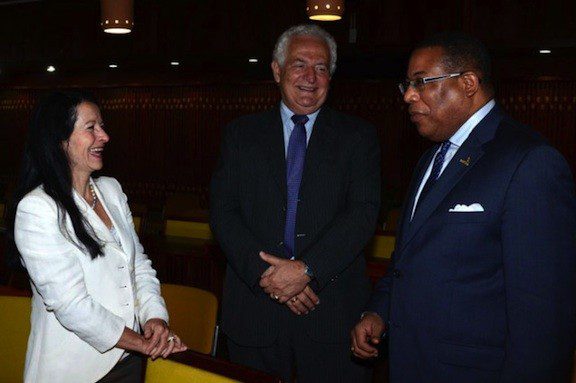Talking Caribbean Small Business with the Inter-American Development Bank
By Alexander Britell
The Inter-American Development Bank recently released a report containing the findings of a survey of 190 banks in the Latin America-Caribbean region. The bank wanted to gauge attitudes of commercial institutions in the area about small and medium sized enterprises. What the IDB found was that the majority of banks are optimistic about the potential of small business, and are looking to increase their financing in this segment. To learn more, Caribbean Journal talked to Francisco Rojo, a specialist at the Multilateral Investment Fund, a member of the Inter-American Development Bank, about the survey, why banks are looking to Caribbean small business, and the relationship between small businesses and development.
What is the main takeaway from this survey in your view?
From my point of view, the main results are that the banks are looking again back to the SMEs – we can see that – it went from 66 percent of their lending to 93 percent, even higher than 2006. The banks say they are thinking that SMEs are going to grow highly in the following two years, so we are seeing demand for projects, and seeing how the commercial banks are very interested in financing SMEs. One other interesting thing for me, which comes both from the survey and from our experience dealing with commercial banks, is that banks that want to downscale are looking for scaling models, and most of the commercial banks are trying to see how they can use the costs associated to provide loans to SMEs.
How do you see this trend playing out in the Caribbean in particular?
We have demand from several Caribbean banks. We are working a lot in Jamaica, for example, and we are receiving a lot of requests from banks that want to do downscaling, and some of them are looking for credit scaling. So we think that these two things are things that are also happening in the Caribbean.
What is motivating this return to small business lending?
Well, we asked that question [in the survey], and there are many results. I would say that the most important would be that they are getting a high return on lending to SMEs, so the return would be the first answers. But the other answer is that they also want to diversify their portfolio, and looking for new segments and new customers. I’m seeing many banks that are getting very complicated increasing their financing in the corporate segment, and are looking to downscale.
In underdeveloped economies, there are a lot of microenterprises, and some big enterprises, but there are much fewer small- and medium-sized enterprises than there are in developed economies. This is now the ‘missing middle.’
How much of a relationship is there between development and the rate of small and medium sized enterprises?
I believe in that case, it’s very high. What we find is, that we looked, and in underdeveloped economies, there are a lot of microenterprises, and some big enterprises, but there are much fewer small- and medium-sized enterprises than there are in developed economies. This is now the “missing middle.” So when we take that into account, we see one of the main areas where SMEs say they’re challenged is in financing. So I think providing more access to finance this segment can increase the amount of companies that can grow, and try to change the shape of this curve in developing countries. We want to try to see more about what’s happening in developing countries that are trying to increase the number of microenterprises that become small- and medium-sized enterprises. Because that’s not what’s happening in many of the Latin American countries – if you take a look at the curve, it’s a little bit of a “U” shape – with lots of microenterprises, less small- and medium-sized enterprises and then big companies. So we are seeing that – and we are trying to provide more lending. For example, since our creation, we decided to have SMEs as a priority, because we think that financing is already developing for microenterprises in most of the Latin American countries, but it’s not for those businesses that are too big for microfinance, but too small for commercial banks.
What is the attitude toward small business among banks in the Caribbean?
I think they acknowledge it, and the demand for financing and also from our side to work with downscaling is also increasing in the Caribbean. So this can be an indicator that shows that financial institutions in the Caribbean are paying attention to this segment. From their point of view, it’s important to increase lending, and from a development point of view, we can look at SMEs to support them in order to help them grow.
Returning to the question of development – is it that developed countries happen to have a lot of small businesses, or is that small businesses actually fuel development?
That’s a good question – which is first, the chicken or the egg? From my point of view, what we can see is that in many undeveloped economies, there are too many microenterprises – first of all, because of the necessity. Most of those microenterprises are not “opportunity” enterprises – they are necessity enterprises. They are people that cannot find a job and have to come up with their own business. In developed countries, it’s a bit different, in that most of the companies are created for opportunity. That’s a trend that we can see – as the economy gets better, the amount of microenterprises is reduced. So in that sense, we can say that because it’s a developed economy you have less microenterprise. But at the same time, what we are not seeing in Latin America or other undeveloped countries is the high growth of many of the small companies. It’s very hard to find many examples in Latin America of a small company that grew in the last 10 years. And that’s something that is happening all the time in developed economies – because the system supports the growth – both with lending, but also the ecosystem, in terms of policy, regulation, etc. So in that sense, I believe that the existence of financing, as well as other things like policy is something that will help a lot of these microenterprises that have growth potential to really grow.
Is there any kind of pattern to the way banks in the region choose to make these SME loans?
Reading the survey, and also from our experience dealing with financial institutions, there is not a clear pattern of the best way banks finance this segment internally. We had a question of where the destination of this financing is located in the bank, or who is the person in charge of deciding the strategy of SME lending, and we got a lot of different answers. It’s very interesting, because each bank is trying to develop its own internal structure in order to support this segment, and I think that right now we cannot say. It depends on the culture — the culture of the country, and the culture of the institution.







